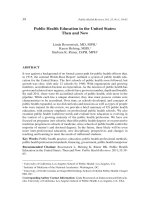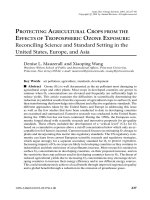Social Stratification and Mobility in the United States
Bạn đang xem bản rút gọn của tài liệu. Xem và tải ngay bản đầy đủ của tài liệu tại đây (2.37 MB, 11 trang )
Social Stratification and Mobility in the United States
Social Stratification and
Mobility in the United States
Bởi:
OpenStaxCollege
Most sociologists define social class as a grouping based on similar social factors like
wealth, income, education, and occupation. These factors affect how much power and
prestige a person has. Social stratification reflects an unequal distribution of resources.
In most cases, having more money means having more power or more opportunities.
Stratification can also result from physical and intellectual traits. Categories that affect
social standing include family ancestry, race, ethnicity, age, and gender. In the United
States, standing can also be defined by characteristics such as IQ, athletic abilities,
appearance, personal skills, and achievements.
Standard of Living
In the last century, the United States has seen a steady rise in its standard of living, the
level of wealth available to a certain socioeconomic class in order to acquire the material
necessities and comforts to maintain its lifestyle. The standard of living is based on
factors such as income, employment, class, poverty rates, and affordability of housing.
Because standard of living is closely related to quality of life, it can represent factors
such as the ability to afford a home, own a car, and take vacations.
In the United States, a small portion of the population has the means to the highest
standard of living. A Federal Reserve Bank study in 2009 showed that a mere one
percent of the population holds one third of our nation’s wealth (Kennickell 2009).
Wealthy people receive the most schooling, have better health, and consume the most
goods and services. Wealthy people also wield decision-making power. Many people
think of the United States as a “middle-class society.” They think a few people are rich,
a few are poor, and most are pretty well off, existing in the middle of the social strata.
But as the study above indicates, there is not an even distribution of wealth. Millions
of women and men struggle to pay rent, buy food, find work, and afford basic medical
care.
In the United States, as in most high-income nations, social stratifications and standards
of living are in part based on occupation (Lin and Xie 1988). Aside from the obvious
1/11
Social Stratification and Mobility in the United States
impact that income has on someone’s standard of living, occupations also influence
social standing through the relative levels of prestige they afford. Employment in
medicine, law, or engineering confers high status. Teachers and police officers are
generally respected, though not considered particularly prestigious. On the other end of
the scale, some of the lowest rankings apply to positions like waitress, janitor, and bus
driver.
Social Classes in the United States
Does taste or fashion sense indicate class? Is there any way to tell if this young man comes from
an upper, middle, or lower class background? (Photo courtesy of Kelly Bailey/flickr)
Does a person’s appearance indicate class? Can you tell a man’s education level based
on his clothing? Do you know a woman’s income by the car she drives? There may have
been a time in the United States when people’s class was more visibly apparent. Today,
however, it is harder to determine class.
For sociologists, too, categorizing class is a fluid science. Sociologists general identify
three levels of class in the United States: upper, middle, and lower class. Within each
class, there are many subcategories. Wealth is the most significant way of distinguishing
classes, because wealth can be transferred to one’s children, perpetuating the class
structure. One economist, J.D. Foster, defines the 20 percent of America’s highest
earners as “upper income,” and the lower 20 percent as “lower income.” The remaining
60 percent of the population make up the middle class. But by that distinction, annual
household incomes for the middle class range between $25,000 and $100,000 (Mason
and Sullivan 2010). How can a person earning $25,000 a year have the same standing as
someone earning $100,000 a year—four times as much?
One sociological perspective distinguishes the classes, in part, according to their relative
power and control over their lives. The upper class not only have power and control over
their own lives, their social status gives them power and control over others’ lives as
well. The middle class don’t generally control other strata of society, but they do exert
2/11
Social Stratification and Mobility in the United States
control over their own lives. In contrast, the lower class has little control over their work
or lives. Below, we will explore the major divisions of American social class and their
key subcategories.
Upper Class
Members of the upper class can afford to live, work, and play in exclusive places designed for
luxury and comfort. (Photo courtesy of PrimeImageMedia.com/flickr)
The upper class is considered America’s top, and only the powerful elite get to see the
view from there. In the United States, people with extreme wealth make up one percent
of the population, and they own one-third of the country’s wealth (Beeghley 2008).
Money provides not just access to material goods, but also access to power. America’s
upper class wields a lot of power. As corporate leaders, their decisions affect the job
status of millions of people. As media owners, they shape the collective identity of the
nation. They run the major network television stations, radio broadcasts, newspapers,
magazines, publishing houses, and sports franchises. As board members of the most
influential colleges and universities, they shape cultural attitudes and values. As
philanthropists, they establish foundations to support social causes they believe in. As
campaign contributors, they influence politicians and fund campaigns, sometimes to
protect their own economic interests.
American society has historically distinguished between “old money” (inherited wealth
passed from one generation to the next) and “new money” (wealth you have earned and
built yourself). While both types may have equal net worth, they have traditionally held
different social standing. People of old money, firmly situated in the upper class for
generations, have held high prestige. Their families have socialized them to know the
customs, norms, and expectations that come with wealth. Often, the very wealthy don’t
work for wages. Some study business or become lawyers in order to manage the family
fortune. Others, such as Paris Hilton, capitalize on being a rich socialite and transform
that into celebrity status, flaunting a wealthy lifestyle.
3/11
Social Stratification and Mobility in the United States
However, new money members of the upper class are not oriented to the customs and
mores of the elite. They haven’t gone to the most exclusive schools. They have not
established old-money social ties. People with new money might flaunt their wealth,
buying sports cars and mansions, but they might still exhibit behaviors attributed to the
middle and lower classes.
The Middle Class
These members of a club likely consider themselves middle class. (Photo courtesy of United Way
Canada-Centraide Canada/flickr)
Many people call themselves middle class, but there are differing ideas about what that
means. People with annual incomes of $150,000 call themselves middle class, as do
people who annually earn $30,000. That helps explain why, in the United States, the
middle class is broken into upper and lower subcategories.
Upper-middle-class people tend to hold bachelor’s and postgraduate degrees. They’ve
studied subjects such as business, management, law, or medicine. Lower-middle-class
members hold bachelor’s degrees or associate’s degrees from two-year community or
technical colleges.
Comfort is a key concept to the middle class. Middle-class people work hard and live
fairly comfortable lives. Upper-middle-class people tend to pursue careers that earn
comfortable incomes. They provide their families with large homes and nice cars. They
may go skiing or boating on vacation. Their children receive quality education and
health care (Gilbert 2010).
In the lower middle class, people hold jobs supervised by members of the upper
middle class. They fill technical, lower-level management, or administrative support
positions. Compared to lower-class work, lower-middle-class jobs carry more prestige
and come with slightly higher paychecks. With these incomes, people can afford a
decent, mainstream lifestyle, but they struggle to maintain it. They generally don’t have
enough income to build significant savings. In addition, their grip on class status is more
4/11
Social Stratification and Mobility in the United States
precarious than in the upper tiers of the class system. When budgets are tight, lowermiddle-class people are often the ones to lose their jobs.
The Lower Class
This man is a custodian at a restaurant. His job, which is crucial to the business, is considered
lower class. (Photo courtesy of Frederick Md Publicity/flickr)
The lower class is also referred to as the working class. Just like the middle and upper
classes, the lower class can be divided into subsets: the working class, the working poor,
and the underclass. Compared to the lower middle class, lower-class people have less of
an educational background and earn smaller incomes. They work jobs that require little
prior skill or experience, often doing routine tasks under close supervision.
Working-class people, the highest subcategory of the lower class, often land decent
jobs in fields like custodial or food service. The work is hands-on and often physically
demanding, such as landscaping, cooking, cleaning, or building.
Beneath the working class is the working poor. Like the working class, they have
unskilled, low-paying employment. However, their jobs rarely offer benefits such as
healthcare or retirement planning, and their positions are often seasonal or temporary.
They work as sharecroppers, migrant farm workers, housecleaners, and day laborers.
Some are high school dropouts. Some are illiterate, unable to read job ads. Many do
not vote because they do not believe that any politician will help change their situation
(Beeghley 2008).
How can people work full time and still be poor? Even working full time, millions of
the working poor earn incomes too meager to support a family. Minimum wage varies
from state to state, but in many states it is $7.25 (Department of Labor 2011). At that
rate, working 40 hours a week earns $290. That comes to $15,080 a year, before tax and
deductions. Even for a single person, the pay is low. A married couple with children will
have a hard time covering expenses.
5/11
Social Stratification and Mobility in the United States
The underclass is America’s lowest tier. Members of the underclass live mainly in
inner cities. Many are unemployed or underemployed. Those who do hold jobs typically
perform menial tasks for little pay. Some of the underclass are homeless. For many,
welfare systems provide a much-needed support through food assistance, medical care,
housing, and the like.
Social Mobility
Social mobility refers to the ability to change positions within a social stratification
system. When people improve or diminish their economic status in a way that affects
social class, they experience social mobility.
Upward mobility refers to an increase—or upward shift—in social class. In the United
States, people applaud the rags-to-riches achievements of celebrities like Jennifer Lopez
or Michael Jordan. Bestselling author Stephen King worked as a janitor prior to being
published. Oprah Winfrey grew up in poverty in rural Mississippi before becoming
a powerful media personality. There are many stories of people rising from modest
beginnings to fame and fortune. But the truth is that relative to the overall population,
the number of people who launch from poverty to wealth is very small. Still, upward
mobility is not only about becoming rich and famous. In the United States, people who
earn a college degree, get a job promotion, or marry someone with a good income may
move up socially.
Downward mobility indicates a lowering of one’s social class. Some people move
downward because of business setbacks, unemployment, or illness. Dropping out of
school, losing a job, or becoming divorced may result in a loss of income or status and,
therefore, downward social mobility.
Intergenerational mobility explains a difference in social class between different
generations of a family. For example, an upper-class executive may have parents who
belonged to the middle class. In turn, those parents may have been raised in the lower
class. Patterns of intergenerational mobility can reflect long-term societal changes.
Intragenerational mobility describes a difference in social class that between different
members of the same generation. For example, the wealth and prestige experienced by
one person may be quite different from that of his or her siblings.
Structural mobility happens when societal changes enable a whole group of people
to move up or down the social class ladder. Structural mobility is attributable to
changes in society as a whole, not individual changes. In the first half of the 20th
century, industrialization expanded the U.S. economy, raising the standard of living
and leading to upward structural mobility. In today’s work economy, the recession and
the outsourcing of jobs overseas have contributed to high unemployment rates. Many
6/11
Social Stratification and Mobility in the United States
people have experienced economic setbacks, creating a wave of downward structural
mobility.
Many Americans believe that people move up in class because of individual efforts
and move down by their own doing. In the example of the siblings Michael and Lisa,
Lisa may have had more intelligence, drive, and ambition than her brother. She may
have worked harder. However, Lisa’s story can also be explained in the context of
structural mobility. Lisa grew up during a time of expanding opportunities for women,
opportunities that were not so readily available to her mother. She may have felt
encouraged by her college mentors to pursue a higher degree, and she may have felt
rewarded when she did so. If Michael and Lisa had grown up in an earlier era, their life
paths may have been completely different.
When analyzing the trends and movements in social mobility, sociologists consider all
modes of mobility. Scholars recognize that mobility is not as common or easy to achieve
as many people think. In fact, some consider social mobility a myth.
Class Traits
Class traits, also called class markers, are the typical behaviors, customs, and norms that
define each class. Class traits indicate the level of exposure a person has to a wide range
of cultures. Class traits also indicate the amount of resources a person has to spend on
items like hobbies, vacations, and leisure activities.
People may associate the upper class with enjoyment of costly, refined, or highly
cultivated tastes—expensive clothing, luxury cars, high-end fund-raisers, and opulent
vacations. People may also believe that the middle and lower classes are more likely
to enjoy camping, fishing, or hunting, shopping at large retailers, and participating
in community activities. It is important to note that while these descriptions may be
class traits, they may also simply be stereotypes. Moreover, just as class distinctions
have blurred in recent decades, so too have class traits. A very wealthy person may
enjoy bowling as much as opera. A factory worker could be a skilled French cook. A
billionaire might dress in ripped jeans, and a low-income student might own designer
shoes.
These days, individual taste does not necessarily follow class lines. Still, you are not
likely to see someone driving a Mercedes living in an inner-city neighborhood. And
most likely, a resident of a wealthy gated community will not be riding a bicycle to
work. Class traits often develop based on cultural behaviors that stem from the resources
available within each class.
Turn-of-the-Century “Social Problem Novels”: Sociological Gold Mines
7/11
Social Stratification and Mobility in the United States
Class distinctions were sharper in the 19th century and earlier, in part because people
easily accepted them. The ideology of social order made class structure seem natural,
right, and just.
In the late 19th and early 20th centuries, American and British novelists played a role
in changing public perception. They published novels in which characters struggled
to survive against a merciless class system. These dissenting authors used gender and
morality to question the class system and expose its inequalities. They protested the
suffering of urbanization and industrialization, drawing attention to these issues.
These “social problem novels,” sometimes called Victorian realism, forced middle-class
readers into an uncomfortable position: they had to question and challenge the natural
order of social class.
For speaking out so strongly about the social issues of class, authors were both praised
and criticized. Most authors did not want to dissolve the class system. They wanted to
bring about an awareness that would improve conditions for the lower classes, while
maintaining their own higher class positions (DeVine 2005).
Soon, middle-class readers were not their only audience. In 1870, Forster’s Elementary
Education Act required all children ages 5 through 12 in England and Wales to attend
school. The act increased literacy levels among the urban poor, causing a rise in
sales of cheap newspapers and magazines. Additionally, the increasing number of
people who rode public transit systems created a demand for “railway literature,” as
it was called (Williams 1984). These reading materials are credited with the move
toward democratization in England. By 1900 the British middle class established a rigid
definition for itself, and England’s working class also began to self-identify and demand
a better way of life.
Many of the novels of that era are seen as sociological goldmines. They are studied as
existing sources because they detail the customs and mores of the upper, middle, and
lower classes of that period in history.
Examples of “social problem” novels include Charles Dickens’s The Adventures of
Oliver Twist (1838), which shocked readers with its brutal portrayal of the realities
of poverty, vice, and crime. Thomas Hardy’s Tess of the d’Urbervilles (1891) was
considered revolutionary by critics for its depiction of working-class women (DeVine
2005), and American novelist Theodore Dreiser’s Sister Carrie (1900) portrayed an
accurate and detailed description of early Chicago.
8/11
Social Stratification and Mobility in the United States
Summary
There are three main classes in the United States: upper, middle, and lower class. Social
mobility describes a shift from one social class to another. Class traits, also called class
markers, are the typical behaviors, customs, and norms that define each class.
Section Quiz
In the United States, most people define themselves as:
1. middle class
2. upper class
3. lower class
4. no specific class
Answer
A
Structural mobility occurs when:
1. an individual moves up the class ladder
2. an individual moves down the class ladder
3. a large group moves up or down the class ladder due to societal changes
4. a member of a family belongs to a different class than his or her siblings
Answer
C
The behaviors, customs, and norms associated with a class are known as:
1. class traits
2. power
3. prestige
4. underclass
Answer
A
Which of the following scenarios is an example of intergenerational mobility?
1. A janitor belongs to the same social class as his grandmother did.
2. An executive belongs to a different class than her parents.
3. An editor shares the same social class as his cousin.
9/11
Social Stratification and Mobility in the United States
4. A lawyer belongs to a different class than her sister.
Answer
B
Occupational prestige means that jobs are:
1. all equal in status
2. not equally valued
3. assigned to a person for life
4. not part of a person’s self-identity
Answer
B
Short Answer
Which social class do you and your family belong to? Are you in a different social class
than your grandparents and great-grandparents? Does your class differ from your social
standing, and, if so, how? What aspects of your societal situation establish you in a
social class?
What class traits define your peer group? For example, what speech patterns or clothing
trends do you and your friends share? What cultural elements, such as taste in music or
hobbies, define your peer group? How do you see this set of class traits as different from
other classes either above or below yours?
Write a list of 10–20 class traits that describe the environment of your upbringing.
Which of these seem like true class traits, and which seem like stereotypes? What items
might fall into both categories? How do you imagine a sociologist might address the
conflation of class traits and stereotypes?
Further Research
PBS made a documentary about social class called “People Like Us: Social Class in
America.” The filmmakers interviewed people who lived in Park Avenue penthouses
and Appalachian trailer parks. The accompanying website is full of information,
interactive games, and life stories from those who participated. Read about it at
/>
10/11
Social Stratification and Mobility in the United States
References
Beeghley, Leonard. 2008. The Structure of Social Stratification in the United States.
Upper Saddle River, NJ: Prentice Hall.
DeVine, Christine. 2005. Class in Turn-of-the-Century Novels of Gissing, James, Hardy
and Wells. London: Ashgate Publishing Co.
Gilbert, Dennis. 2010. The American Class Structure in an Age of Growing Inequality.
Newbury Park, CA: Pine Forge Press.
Kennickell, Arthur B. 2009. Ponds and Streams: Wealth and Income in the U.S., 1989 to
2007. January 7. Retrieved January 10, 2012 ( />2009/200913/200913pap.pdf).
Lin, Nan, and Wen Xie. 1988. “Occupational Prestige in Urban China.” American
Journal of Sociology 93(4):793–832.
Mason, Jeff and Andy Sullivan. 2010. “Factbox: What Is Middle Class in the United
States?” Reuters, September 14. Retrieved August 29, 2011 ( />article/2010/09/14/us-usa-taxes-middleclass-idUSTRE68D3QD20100914).
United States Department of Labor. 2001. “Wage and Hour Division: Minimum Wage
Laws in the States—January 1, 2011.” Retrieved January 10, 2012 ( />whd/minwage/america.htm).
Williams, Raymond. 1984 [1976]. Keywords: A Vocabulary of Culture and Society.
New York: Oxford University Press.
11/11









